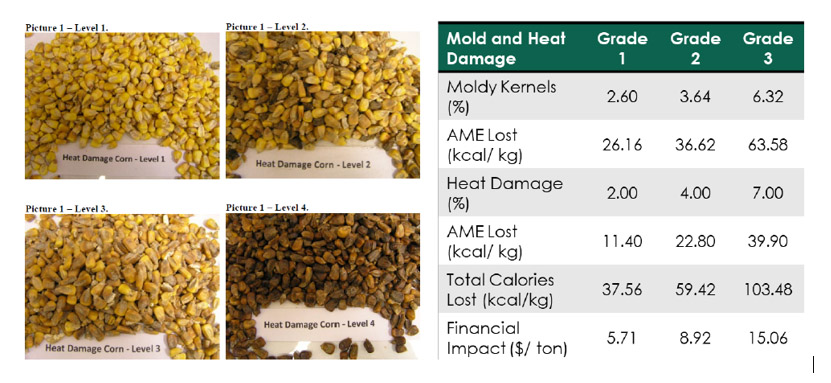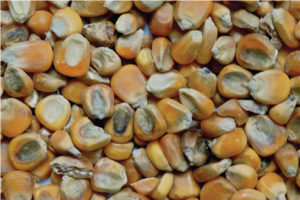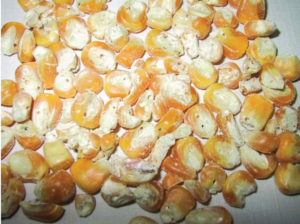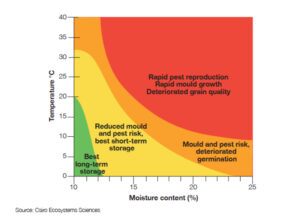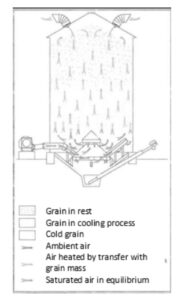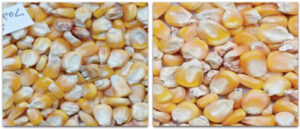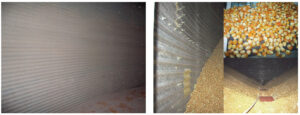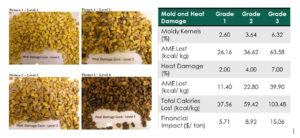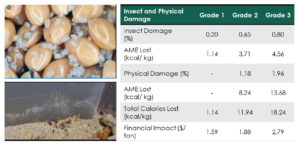Grain Storage Challenges to Poultry Feed Manufacturers: Tips for Good Management Practices
Synopsis: Understanding the role of water activity in maintaining the vital nutrients and protecting it from the microorganisms will be probably the most significant advancement made by poultry feed manufacturers. Water activity (aw) is one of the most critical factors for determining the quality and safety of feed and grain. It quantifies the amount of “free” water available in materials for use by microorganisms and chemical agents.
About the author
Dr. Naveen Kumar
Dr Naveen Kumar , B.V.Sc & A.H (Gold Medalist), M.V.Sc (IVRI, Bareilly) is a food & oil seed grains storage specialist and a finished feed quality expert for Asian and other tropical countries. He also Business Director of Delst Asia and is located in Faridabad, India. He can be reached at naveensharma21@gmail.com.
To face up to the extremely challenging tropical hot and humid weather condition, maintaining overall grain quality over storage requires an in-depth understanding of the sciences involving:
- Water activity, Moisture movement
- Good silo design and good silo management program
- Intake grain quality and length of storage.
This article focusses on Water activity (aw), reasons for rot, Bio-deterioration, Moisture migration and Corrosion, Grain respiration, Shrinkage, Fungus and Mold and Insect infestation.
Charting Water Activity in Silos
Over the entire storage period, good quality grain will continue to degrade in quality. Grains degrade 10 times faster in the tropics due to the very adverse weather condition posed by hot scorching afternoon sun, the occasional burst of rain, high humidity and temperature difference between hot days and cold nights. At best, proper grain storage management can only help minimise the damage.
It only takes about 2-3 weeks for an onset of the many negative elements to start degrading the stored corn, and thereafter, rapidly worsening over time. Degradation in grain quality relates to nutrient degradation, bio-degradation, insect and mite infestation, physical structure damage, mold contamination and grain respiration, which leads to weight or moisture shrink. All these damaging losses has an economic impact and cannot be taken lightly.
What actually starts the rot?
Water activity (aw)
The most important property of water in food systems is the water activity (aw) of food. Water activity is the ratio of the vapor pressure of water in equilibrium with a food to the saturation vapor pressure of water at the same temperature. The water activity of a food describes the degree to which the water is “bound” in the food and hence its availability to act as a solvent and participate in chemical or biochemical reactions and the growth of microorganisms. It is an important property that can be used to predict the stability and safety of food with respect to microbial growth, rates of deterioration, chemical and physical properties (Mathlouthi, 2001).
At aw of 0.70 and above, mold starts to grow which inflicts great damage to the grain quality. The water activity and the propensity for mold growth increases with temperature (Tapia et al., 2020). Shelled corn can be safely stored for a year at a moisture content of 13% and a temperature of 10℃. However, the same corn stored at 32℃ can be substantially be damaged by mold within 2 months. This is why it is so much easier to store grains in the cold regions but extremely challenging in tropical regions.
Bio-deterioration
The inherent enzymes present in the seed causes bio-deterioration. The extent of deterioration depends upon the rate of enzyme activity, which is affected by free water and temperature. Biodeterioration results in degradation of nutrients and contamination with anti-nutritional factors.
Nutritional impairment in degraded corn during storage is of great consequence to the health, nutrition and performance of the animals, while directly affecting the profitability of an organization.
Moisture migration
This is the spark that starts the fire and all other problems we face with grain degradation. Moving free water that leached out of grains is the primary cause of grain degradation. This is a natural phenomenon due to the huge temperature difference between day and night throughout the storage period. The difference in temperature causes moisture to move from a region of higher temperature to lower temperature. Moisture will start to migrate if the difference of temperature variance is more than 5℃. The movement of free water is further assisted by convective air current flow inside the silo. This convection air flow moves free moisture to localise spot, and consequently increases water activity, promoting mold growth, insect, and mite infestation.
As steel is a good conductor of heat, the silo wall is easily affected by weather conditions, impacting grain temperature nearer to the wall.
In a cold weather scenario, the cold temperature outside the silo results in the grain and air nearer to the wall to be colder while the center is relatively warmer. This forms a convection air flow that moves downward alongside the wall through the grain. As the air current moves downward and up again through the warmer center, the air starts to warm up from the warm grains and picks up moisture. As warm air rises, it cools because of the colder temperature near the roof, resulting in condensation on the top of grain mass.
In a hot tropical weather scenario, the hot temperature outside the silo results in the grain and air nearer to the wall to be warmer while the center is relatively colder. This forms a convection air flow that moves upward alongside the wall through the grain. As the air current flows upward and down through the cooler center, the air starts to pick up moisture along the passage, leading to moisture condensation towards the bottom silo floor. This phenomenon is most commonly seen in tropical countries, where the silo external surface can be heated to approximately 60℃ in the afternoon and quickly cooled down to about 22-25℃ at night.
Left picture dictates air flow current in a cold weather scenario while Right picture shows air flow current in a hot tropical weather condition.
Moisture migration occurs quite readily in regions with extreme day and night temperature, as in the Middle East, harsh tropical and equatorial climates. Storing grains at 13-14% in cooler climates is fair game, but however, in hot climates, it is very challenging which involve a totally different approach.
Typically, free water in the grain mass tend to migrate towards the cooler areas in a silo, which is usually the shaded part from the sun, the floor and the lower half of the silo. This is where you will observe sweated patches clinging to the silo wall and at the bottom of silo after gravity unloading.
The increased aw from moisture migration supports microbial and micro-flora growth, leading to spontaneous heating and eventually causes grain respiration. Heavily contaminated caked layer adhering to the silo sidewall must be properly cleaned and disposed of to control corrosion, contamination in feed production and future seeding of problems.
Corrosion
Corrosion of galvanized steel silos is due primarily to moisture ingress and the consequent degradation of the sweated corn fermenting and producing a complex mixture of chemicals amongst which are formic and acetic acids, both of which are extremely aggressive and damaging on the galvanized coating protection layer, and eventually corroding the unprotected exposed steel surface.
Left picture shows corroded internal side wall of silo. Right picture depicts collapsed silo due to corrosion.
Worst- and best-case scenarios for continued exposure to damp corn predict that the total useful service life of the silos can be reduced by half if corrosion is left unchecked or proper remedial maintenance to the corroded surface is not looked into. Many silos failed because of corrosion and neglect.
Grain respiration
Grain respires once it detects sufficient heat and moisture. This is the reason why feed mills dread storing corn above 14% moisture content. The hot pounding tropical sun with its strong UV rays in the middle of noon will drastically increase the surface temperature of the upper part of silo to a temperature way above ambient temperature. Just like the car roof which gets heated up to a very high temperature from the hot afternoon sun which burns upon touching.
The increase in temperature leads to an increase in respiration rate and consequently shrinkage, especially in the tropics. When grain respire, starch and oxygen are converted to carbon dioxide as well as water and heat, leading to the onset of even more aggressive and uncontrollable respiration.
Shrinkage
Shrinkage is physically noticeable and contributes to financial losses as weight loss in grain storage. However, in addition to weight loss, shrinkage causes irreversible changes to starch molecules, especially to amylose and protein matrixes that encapsulate individual starch granules within the endosperm of the corn kernel.
Depending on the grain intake moisture and storage time, moisture shrink can range from 0.5-3.0%, which is a substantial weight loss.
Moisture loss causes starch retrogradation, which limits digestibility and nutrient availability to the animal. This is an important factor why animal fed with fresh high moisture corn performs better than old dry corn. Shrinkage of corn due to moisture loss also has a negative impact on feed pelleting, since less moisture is being relayed to the compounded meal, resulting in poor steam conditioning and cooking of starch, a low degree of starch gelatinization and hence affecting the overall pellet quality.
Fungus and Mold
Fungus refers to a group of unicellular or multicellular organisms, which feed on organic matter. It includes mold, mushrooms and yeast. Fungus that are usually involved in deterioration of grain have been classified as field fungi, storage fungi, and advanced decay fungi depending on the time of their invasion and colonization of grains before or post-harvest (Afsah et al., 2013). Mold, are multicellular microscopic fungi, typically characterized by the presence of hyphae filaments. Their life cycle is divided into four phases: sporulation, germination, hyphal growth (vegetative growth) and reproduction. The spore stage is where a mold is dormant, allowing mold to endure harsh environments such as extreme temperature and dry conditions. Once mold spores obtain adequate nourishment and moisture, they will germinate and form hyphae. From this time onwards, fungi metabolize the grains by extracting the necessary nutrients and retaining moisture needed for growth, which ultimately poses a biosecurity threat to feed and animal (D’orazio, 2012).
In tropical conditions, Aspergillus spp. are prolific storage fungi in grains as it favours hot conditions with 13-20% moisture and relative humidity of 65-90% depending on the species. They can spontaneously produce heat up to 55°C, resulting in spontaneous heating in grain mass (Atanda et al., 2011). These molds are abundant in the environment and present on all corn kernels surface. It is important to control moisture and water activity to prevent mold proliferation and its damaging consequences. This mold is also often associated with granary weevil activities, which is usually an issue in long period storage.
Mold is a living organism and its growth is influenced by moisture, temperature, oxygen, and substrates. Moisture is the most critical among these factors. Mold unable to grow when the moisture in grains is less than 12%. When the moisture is increased above 12%, molds will start to germinate and grow. Molds proliferate when moisture is above 17% (D’orazio, 2012). Humidity affects grain moisture which makes it extremely challenging to store corn in bags or bulk in an open warehouse.
Molds not only produce mycotoxins but also damage and reduce the nutritional value of grains. Actively growing molds utilise carbohydrates present in grains to produce carbon dioxide, water and heat, leading to reduction of energy value and nutrients degradation of grains or feed.
It is difficult to control fungal contamination in well-dried shelled corn of 13-14% moisture, stored in a steel silo or as bags in a warehouse in tropical condition. Insect infestation due to moisture migration can also further contribute to temperature rise in grains. The combination of mold contamination and insect infestation increases water activity, resulting in an increase rate of mold growth. If mold growth is not controlled, the degradation of corn continues as the storage duration prolongs. There is simply no end to all of these issues if there is uncontrolled moisture migration and grain respiration since both generates an excessive amount of free water, increasing the water activity.
Corn contaminated with mold
Insect infestation
Insect infestation is a greater problem in regions with high relative humidity while temperature has the greatest influence on insect multiplication. At approximately 32°C, the rate of multiplication is monthly compounded exponential increase of fifty times the original amount (Yasothai, 2019).
Corn infested by insects
Growth of insect, pests and molds raises both temperature and moisture. Insect infestation is rampant whenever there is heavy sweating in areas where corn layer adheres to the silo wall in patches. Naturally, insects will start to breed and incubate their eggs in a conducive environment which provide a rich food source for its young larvae.
Synopsis: Understanding the role of water activity in maintaining the vital nutrients and protecting it from the microorganisms will be probably the most significant advancement made by poultry feed manufacturers. Water activity (aw) is one of the most critical factors for determining the quality and safety of feed and grain. It quantifies the amount of “free” water available in materials for use by microorganisms and chemical agents.
To face up to the extremely challenging tropical hot and humid weather condition, maintaining overall grain quality over storage requires an in-depth understanding of the sciences involving
- Water activity
- Moisture movement
- Good silo design and silo management program
- Intake grain quality and length of storage.
Silo Design
If space is not a constraint, a practical silo size and capacity is to keep the height of silo as short as economically possible as it can greatly ease aeration and the air flow moving to the top. It is more preferably to have multiple silos with smaller capacity rather than lesser tall silo with huge capacity for the ease to facilitate silo management.
Aeration
Problem with temperature profile within the grain mass and air current movement can be minimised with effective aeration. Aeration is a tool to manage and control grain temperature, equilibrating with ambient temperature. This is needed to control moisture migration, mold contamination, insect infestation and eventually grain degradation.
In cooler environments, aeration is used to blow in cold ambient air to lower grain mass temperature and to suppress insect development and microflora growth. Whereas in the tropics, a good aeration program with a practical knowledge of working with ambient temperature and humidity will help to minimize heat and to equilibrate grain mass temperature within the silo, reducing issues relating to moisture migration.
As moisture migration moves with the natural air current developing from temperature profile within the grain mass, aeration can help in alleviating the phenomena by harmonising grain mass temperature inside the silo.
Picture shows the air current flow after implementing with an aeration system in the tropics. Source from https://www.topcropmanager.com/spring-moisture-migration-in-grainbins-20111/
However, more often than not, aeration system is always under-designed in terms of capacity for the tropics, rendering it unable to cope with dispersing heat in the grain mass. It is more challenging to maintain grain quality in the tropics as the relative humidity ranges from 70-90% while the ambient temperature ranges from 23- 42°C within a day. After a hot day from the scorching sun, a sufficient amount of air flow is required to dispel the heat. Air to grain ratio at a minimum of 0.30-0.40 m3/min air per ton of corn (0.25 cfm per bu) is required. However, most aeration system that comes with the silos are frequently supplied with much lower capacity around 0.11-0.13 cfm per bu range.
A good aeration program with a sound practical approach of working with ambient temperature and humidity will help to minimize heat and to equilibrate grain mass temperature within the silo, reducing issues relating to moisture migration.
In colder countries, the relative humidity is lower than 65% with very cold and cool temperature in most part of the years. This does not post much problems, except to aerate ambient cold air to cool and equilibrate the overall grain mass temperature to the center of the grain mass. The concern is a small period during the warmer summer, as there is now the issue of managing the temperature and humidity variance between day and night.
Graph showing effect of temperature and moisture on stored grain. Source from CSIRO Ecosystem Sciences
Roof ventilation is an important aspect in regulating respirated warm air under the roof space and more nos. of roof vents should be provided for silos in warmer regions. Roof vents should be positioned near the peak of the silo as their function is to remove hot air from headspace. With better efficiency of expelling the warm air coming off the grain, a higher volume of external cooler ambient air can be pulled into the roof space of the eave.
It is strongly recommended to install two units of electric extractor fan per silo for rapid extraction of hot respirated air out to the surrounding.
Good intake management (good filling practices and cleaning to rid dust and foreign material) can assist aerating air flow. Air usually flows along path of least resistance within the silo. Dead space is normally formed due to dust and contamination in grains.
It is advisable to not overfill the silo to the brim but up to the second last ring max, and practice coring after fill. This also assist in better air flow from the roof eve, giving sufficient headspace which also helps in providing a better air cushion between the roof space and the top of grain surface. Hot respirate air has to be continuously extracted out to avoid condensation on the underside of the metal roof at night.
Insulated silo wall is a good option but costly. Insulation prevents temperature differential between day and night, controlling temperature profile to minimize moisture migration. There are three types of insulation which is single sheet, double sheet and a combination of double sheet insulation with insulation material.
Picture showing insulated silo with insulation material. Adapted from https://siloscordoba.com/blog/grain-storage/silo-insulation-systems
Drying and Silo Operation
Drying helps ensures corn moisture to be kept low and uniform within the maximum safety for grain storage. After the drying process, grains should be transferred into a temporary storage silo or a tempering bin to cool them to ambient temperature. Grains that failed to cool sufficiently after drying may cause a heat steeping effect inside the storage silo, leading to moisture condensation and increasing rate of moisture migration in the grain mass.
Picture shows how does a tempering silo works. Source from
Corn loading
Coring method during grain loading.
Source from University of Minnesota Extension
Before loading into the silo, remove dust, fine particles and damaged grains. This eliminates spout lines that decreases the efficiency of aeration. When there are less fines in the grain mass, it is less challenging for storage management as there will be less dead space within the silo, improving air flow distribution and aeration efficiency.
During the loading of grains, there are additional steps for managing fines. Using the center unloading augers to periodically unload some of the grain to remove any remaining fines. This method is often known as coring. When filling, unloading auger is run at least daily or more often to remove the peaked grain, forming an inverted cone with diameter in the range of 5-10 feet. Grains that are removed can be cleaned and mixed with other grain to be putback into the bin.
Mold control begins with moisture control
All the suggested approach (discussed previously) in managing moisture and temperature helps to minimise grain degradation over storage, but moisture migration is still very uncontrollable. This results in corn caking and sweating in the internal wall, leading to mold contamination and grain degradation…Henceforth, the use of mold inhibitors have been a common practice, but always with futile outcome as this is not addressing the root cause of the problem. An effective moisture management program that is able to negate free moisture movement has been proven to contain moisture migration problem in grain storage, hence maintaining the intake quality.
An actual field storage trial on corn storage was conducted, comparing control (with a normal mould inhibitor program) and treatment (with an effective moisture management program). The control was stored for 8 weeks for early feed production use and the treatment corn was stored and stretched to 16 weeks for later feed production use. Both undergoes the same storage program, but the result shows a very significant difference on corn quality at the end of storage. Despite a shorter storage period, the control batch have darkened germ due to mold contamination. As for the treatment corn, the germ still possess a creamy colour, and retaining the original intake quality despite a twice longer storage period.
Left picture shows the control corn stored for 8 weeks. Right picture shows the treatment corn stored for 16 weeks.
With a good moisture management program, the silo wall had minimal caking and corrosion with free flowing and healthy grains after long period of storage of 4-8 months. Controlling moisture migration is an effective approach to lock in water activity at a safe level, preventing microbial growth and hence keeping intake grain quality.
Left picture shows minimal to no caking and no corrosion to the internal silo wall. Right picture shows free flowing corn of intake grain quality after long period of storage.
Financial loss
The first stage loss is moisture loss due to moisture migration. As moisture migrate, air currents developed from temperature profile. The moisture would accumulate on grain surface and evaporates as weather gets hotter or during silo management program. On average, a minimum of 0.5% of moisture is lost with proper silo management, but if it is not managed properly, moisture loss can go up to 1-1.5%. With the current corn’s price, it will cost approximately US$ 1.50-3.00 per ton of corn stored due to moisture loss.
The second stage loss is when silo management is not properly implemented where ventilation fails to remove free moisture. The three main losses in this stage are the loss of carbon, reduced metabolizable energy and heat damage in grains due to mold contamination.
Left: picture depicts different level of heat damage in corn. Right table portrays
different parameters that are affected by mold and heat damage in corn
The third stage of loss is when moisture migrate, causing the corn kernels to dry and their surface becomes brittle. When this occurs, there is a risk of corn fragmentation as grains move in the silo. This will increase the chances of insects and mite infestation. Mite and insects cause physical and nutritional damage to the corn and eventually damaging the livestock production as the presence of mites will cause feed rejection and thus feed wastage and the loss of animal performance.
Left picture shows corn infested with mite and insects. Right table portrays different parameters that are affected by insect and physical damage.
The total amount of loss is alarming. As much as $22.00 per ton of corn is lost in the formulation process. The losses above have yet to include financial impact on farms whereby even minimal mite infestation is able to negatively affect the feed conversion ratio. If losses of nutrients and insect damage are not tackled at source, expensive additives are used to compensate nutrient deficiencies and mask health related problems.
Conclusions
The benchmark to gauge a successful grain storage program is to observe the remaining corn at the bottom of silo after gravity unloading. Ideally, the germ should have a creamy appearance. If the germ area is discoloured even to a slight shade of grey, this is a sign of failed grain storage program. There should also be no visible sign of caking and sweating patches on the side wall. Negligible insect infestation is also a good sign.
The damaging consequence of fungal contamination, loss of nutrients, lost metabolizable energy value of grains greatly impacts feed quality, animal performance and a great economic loss.
All the suggested proper silo engineering set up and silo management practices is to minimize damage if there is a need for long period storage. A proven chemical approach in reducing moisture migration with good aeration management can greatly confine moisture challenge to preserve intake grain quality under the most challenging weather. It is important to control water activity to reduce microorganism activities and degradation of grain. Addressing a pending mold issue with a mold inhibitor treatment is not the answer to keeping grain quality.
The grain and feed industry loses millions of dollars yearly from damaged grain, weight shrink, lost and undigested nutrients, and costs incurred in the attempt to disguise or neutralize problems associated with grain degradation. Much of the repair costs can be cut down if proactive decision is taken to minimise the damage. Proper corn storage management with an effective program will greatly maintain the intake quality and minimise losses.
Featured Silo Image photo created by standret – www.freepik.com
References
Afsah H., Leili S., Jinap, S., Hajeb, P., Radu, S. and Shakibazadeh, Sh. (2013). A Review on Mycotoxins in Food and Feed: Malaysia Case Study. Comprehensive Reviews in Food Science and Food Safety. 12. 10.1111/1541-4337.12029.
Atanda, S.A., Pessu P. O., Agoda S., Isong I. U., Adekalu O. A., Ehendu M. A. and Falade T. C. (2011). Fungi and mycotoxins in stored foods. African Journal of Microbiology Research. 5(25). 4373-4382. 10.5897/AJMR11.487
D’orazio, M. (2012). Materials prone to mould growth. 10.1016/B978-0-85709-122-2.50012-7.
Mathlouthi, M. (2001). Water Content, Water Activity, Water Structure and the Stability of Foodstuffs. Food Control. 12. 409-417. 10.1016/S0956-7135(01)00032-9
Tapia, M.S., Alzamora, S.M. and Chirife, J. (2020). Effects of Water Activity (aw) on Microbial Stability as a Hurdle in Food Preservation. In Water Activity in Foods (eds G.V. Barbosa-Cánovas, A.J. Fontana, S.J. Schmidt and T.P. Labuza). 1002/9781118765982.ch14
Yasothai R. (2019). Storage Losses in Feed Ingredients by Insects and its Control. International
https://www.pashudhanpraharee.com/quality-control-of-feed-and-feed-ingredients/
References
Afsah H., Leili S., Jinap, S., Hajeb, P., Radu, S. and Shakibazadeh, Sh. (2013). A Review on Mycotoxins in Food and Feed: Malaysia Case Study. Comprehensive Reviews in Food Science and Food Safety. 12. 10.1111/1541-4337.12029.
Atanda, S.A., Pessu P. O., Agoda S., Isong I. U., Adekalu O. A., Ehendu M. A. and Falade T. C. (2011). Fungi and mycotoxins in stored foods. African Journal of Microbiology Research. 5(25). 4373-4382. 10.5897/AJMR11.487
D’orazio, M. (2012). Materials prone to mould growth. 10.1016/B978-0-85709-122-2.50012-7.
Mathlouthi, M. (2001). Water Content, Water Activity, Water Structure and the Stability of Foodstuffs. Food Control. 12. 409-417. 10.1016/S0956-7135(01)00032-9
Tapia, M.S., Alzamora, S.M. and Chirife, J. (2020). Effects of Water Activity (aw) on Microbial Stability as a Hurdle in Food Preservation. In Water Activity in Foods (eds G.V. Barbosa-Cánovas, A.J. Fontana, S.J. Schmidt and T.P. Labuza). 1002/9781118765982.ch14
Yasothai R. (2019). Storage Losses in Feed Ingredients by Insects and its Control. International Journal of Science, Environment and Technology. 8(1). 44-49.



